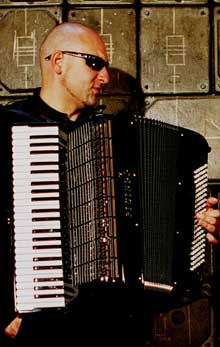"Often I hear the opinion that there is a kind of Polish soul, a very special kind of expression in our music. It seems that it is natural, coming subconsciously, living deep inside us"
Global Air
Marty Lipp explores stacks of bellows with Polish accordionist Janusz Wojtarowicz (of the Motion Trio) and Argentine boxster Chango Spasiuk.
If you think of the bellows of an accordion as the 19th century equivalent of a Marshall amp, you can start to imagine why the instrument spread across the world, muscling into the folk music of country after country.
While the accordion's ancestry can be traced back centuries to China, its name was patented in Paris in 1829 by a Viennese instrument maker, although a German craftsman created an instrument that more closely resembled the modern accordion several years earlier.
By the century's end, factories were mass-producing accordions, so much so that some observers wondered if the instrument would wipe out traditional music. Instead, the accordion took its place alongside other instruments and became the centerpiece of several genres. When immigrants came to the Americas, they brought their squeezeboxes with them: from Argentina to Cape Breton.
During the 20th century, the accordion rose and fell in popularity. Like many of the traditions it was a part of, the accordion came to be considered old-fashioned or worse, "un-cool." What other instrument could have a fan club that calls itself the Closet Accordion Players of America?
With the rediscovery of ethnic and regional music, the accordion has gained respectability. Several recent releases show that it is, artistically at least, in good hands.
 The Motion Trio from Poland is composed of three accordion players who come from a conservatory background, but played on the streets while they attended the Cracow Music Academy.
The Motion Trio from Poland is composed of three accordion players who come from a conservatory background, but played on the streets while they attended the Cracow Music Academy.
The liner notes for their 2005 CD, Pictures From The Street (Asphalt Tango) state, "Accordion traditionalists have run out of ideas, and it is our goal to extract notes from the accordion which have never been heard before."
The group's leader, Janusz Wojtarowicz, says the trio wants "to open the gate of concert halls... To make the presence of the accordion in concert halls as natural as the presence of violin or piano."
"We are working on this idea for a few years," he continued. "We agree with the way of thinking represented by Kronos Quartet: on one hand, classical music; on the other side, searchings, experiments, world music. This wide [perspective] on music is fascinating to us. I hope, in the future, the accordion trio will have the same status of a classical group, such as a string quartet."
Despite the talk of experimentalism and classical music, the songs on "Pictures" are strongly rhythmic and fun, a by-product of the trio's street performances.
Wojtarowicz said, playing on the street "was a great adventure. The street taught us a lot: flair, ability of solving problems, being pushy. It is very important because nowadays being a musician means being a businessman, so to get a result you need to be very creative.
Playing on the streets of Europe and on the streets of the U.S.A. is a different thing. In Europe, despite your playing on the street, you don't stop being an artist. In America, you are just one of the guys earning money, that's it."
Their album, he said, "is a story about the places, people and first of all about the emotions we felt playing street music."
"We don't play folk music," he said, "but quite often I hear the opinion that there is a kind of Polish soul, a very special kind of expression in our music. It seems that it is natural, coming subconsciously, living deep inside us."
Asked if the accordion is still evolving, Wojtarowicz said the word "evolving" brought to mind "developing countries: so the country develops and develops, but generally it is known that never ever will it be on the same status as the other high-developed countries. In my opinion, musicians' society has the same way of thinking about the accordion."
Another unexpected arrival to the U.S. is an album of little-known, accordion-driven music from Argentina called chamame. Unlike Argentina's tango, chamame is an upbeat music that is typically played for dances in the country's rural northeast.
 As played by Chango Spasiuk on his Tarefero de Mis Pagos (Piranha, Germany), the ordinarily earthy chamame can be elegant or ethereal. Spasiuk plays peppy 6/8-rhythm tunes as he would for dancing couples, but he also plays compositions that change rhythm and dynamics like classical pieces.
As played by Chango Spasiuk on his Tarefero de Mis Pagos (Piranha, Germany), the ordinarily earthy chamame can be elegant or ethereal. Spasiuk plays peppy 6/8-rhythm tunes as he would for dancing couples, but he also plays compositions that change rhythm and dynamics like classical pieces.
He said that while chamame continues to flourish in Argentina's northeast, it has never been considered as prestigious as tango.
Explaining the origins of the music, he said, "The original 6/8 African rhythm came down from Peru and is present in many Argentine regions and musics. In about 1500 the Spanish arrived in the region. In 1600 the Jesuit monks arrived over there and settled down. That was the place and the moment of a very important human meeting: the meeting between the Jesuit monks and the Mbya Guarani Indians.
"The Jesuit monks came with musical instruments and tried [to teach] the Indians to play baroque music. They were part of the building of the biggest instrument factory of Latin America - it was located in the city of Yapeyu at that time. In this factory they built violins, harpsichords, and portable organs.
"By the end of 1800, beginnings of 1900, European immigrants started to arrive in the area, with their accordions, their polkas and their schotis. All these facts are inside the chamame...
"Chamame is not a distorted or a transformed European polka...The chamame is a music that historically was being developed and was constituting its own identity and it finished to structure itself through the use of the accordion that the European immigrants brought when they came to these lands.
"The chamame is a strong and visceral music. Sometimes it is played fast, sometimes it is played slowly. But even when in the surface it looks [like] a happy music, it always stays melancholic inside. Why? I don't know.
"Sometimes in the nowadays world, there is a tendency of trying to explain everything, even when there are things that cannot be explained through the language.
Spasiuk named his first international release after the "tarefero," the workers who pick yerba mate tea with their hands. "The mate is the most popular beverage in Argentina and it is drunk all over the country. These plants only grow in Misiones and the north of Corrientes province. And even when the mate is so popular, not all the people in Argentina know the tarefero. They don't know how these men live, how they express themselves and what is their cultural universe. I was born and raised in Apostoles, Misiones....I felt that for my first international record, it was a good idea to show my place and part of the world."
"You can find in my record songs that could be considered 'traditional,'" he said. "I am not trying to be original for the other people, I am trying to be true to myself and to impulses that are difficult to express with words.
"I think that what a musician does is to furnish himself with tools, orchestration, harmonies, arrangements, sometimes simple and sometimes complex, to go in the direction of a search that does not finish with a CD recording.
"It is not my goal or my main purpose," he concluded. "but I feel a kind of happiness when this music can be heard in places that up to now were not expected to be places to play chamame."
In this century, digital technology threatens to eclipse the electric guitar in popular music, but the dexterous and emotionally resonant playing of these emerging artists ensures we'll hear a few more verses before the accordion's final coda. - Marty Lipp
CD available from cdRoots:
Chango Spasiuk
Motion Trio
|



